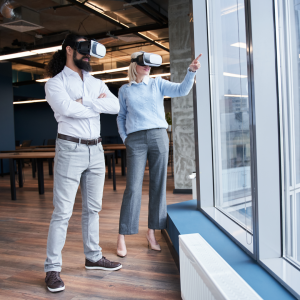Estimated reading time: 3 minutes
Warehousing and Manufacturing workplaces are always looking to revamp their workflow, anything to simplify their day-to-day processes and keep productivity levels high and prospering. From automation to collaborative robots, acting as employees, there is always something new brewing up in this labor-driven industry. Lately, many automotive manufacturers have chosen to implement Virtual Reality (VR), Augmented Reality (AR), Extended Reality (XR), and various other smart methods to help alleviate commonplace tasks, and even cut back on any downtime that can occur in between seeking approval for prototypes, endlessly searching aisles for a product part, or even suffering final consequences with a delay in production due to an employee injury on the clock. The future is looking bright for manufacturing companies looking to onboard additional smart initiatives.
What is Extended Reality?
Extended Reality looks at all-real-and-virtual combined environments and human-to-machine interactions generated by computer technology elements and wearables, where the ‘X’ represents a variable for any current or future spatial computing technologies. Underneath this umbrella, we have Virtual Reality (VR), Augmented Reality (AR), and even Mixed Reality (MR) implementations that do their best to affect the perceptions of workplaces that adopt them into their strategic plans. Extended reality is posed to set its users up for success, in that they are being exposed to a brand-new method of viewing media, through the seamless interactions between real and virtual worlds.
 Listen to The TEConnect Podcast Episode #21: Smart Manufacturing with Honeywell’s Michael Noyes
Listen to The TEConnect Podcast Episode #21: Smart Manufacturing with Honeywell’s Michael Noyes
Devices are Changing Around Us
Additionally, Light Detection and Ranging or LiDAR seeks to bring more realistic visions to devices. This practice works to create 3D mappings of outdated flat graphic planes, most commonly used to mockup prototypes and blueprints sketched up before proposal and launch meetings. This advancement is vital in developing AR creations to have them appear more rooted in structural bases of the real world, avoiding clunky, buffered experiences.
 The size and shape of VR/AR headsets will also change as well. Eye-tracking technology allows the system to focus on the best resolution and image quality on specific parts of an image, including smaller texts and more refined features. This way, systems are able to reduce any chance of excessive nausea one might feel when utilizing a device on the job. Hand-detection allows VR users to control movements without clunky controllers, cords, and wires getting in the way, allowing people to get more expressive with their movements, especially for all the hand-talkers out there.
The size and shape of VR/AR headsets will also change as well. Eye-tracking technology allows the system to focus on the best resolution and image quality on specific parts of an image, including smaller texts and more refined features. This way, systems are able to reduce any chance of excessive nausea one might feel when utilizing a device on the job. Hand-detection allows VR users to control movements without clunky controllers, cords, and wires getting in the way, allowing people to get more expressive with their movements, especially for all the hand-talkers out there.
Read More on the TEConnect Portal – Virtual Reality in the Workplace: What’s at Stake?
AR & VR’s Role in Manufacturing
In its foundational stage, Virtual Reality can introduce how a product functions and operates without having to create a physical 3D-printed prototype. In many automotive markets, engineers are able to tap in remotely to engage in virtual vehicle environments, granting them access to showcase features and troubleshoot where it’s necessary. From the standpoint of mastering your inventory management strategies, AR technology helps to eliminate any confusion that may pop up, as to where a series of products is located, and simplifies the organizational process for everyone who’s involved. If a warehouse worker were to be positioning their tablet device in the right direction, they could enable AR to pinpoint exactly where a specific product was shelved, giving additional directions along the way. Cutting out the guesses and empty knowledge for future tasks is essential in this aspect, especially on a deadline.
Keeping Everyone Safe
 The likelihood for accidents and incidents to occur while working on the job in a labor-driven role, such as manufacturing, is common, but employees and managers do everything they can to prevent such things from happening. With the help of smart technology such as VR, managers are able to predict the probability of dangers such as hazards, spills, and any other disruptions that could both harm employees and cut back on workplace productivity rates altogether. To detect and identify threats before they actually happen, reducing the downtime that would occur in the aftermath, cutting down on repair expenses from broken and faulty equipment, to even doubling up on the level of employee safety and security all the while.
The likelihood for accidents and incidents to occur while working on the job in a labor-driven role, such as manufacturing, is common, but employees and managers do everything they can to prevent such things from happening. With the help of smart technology such as VR, managers are able to predict the probability of dangers such as hazards, spills, and any other disruptions that could both harm employees and cut back on workplace productivity rates altogether. To detect and identify threats before they actually happen, reducing the downtime that would occur in the aftermath, cutting down on repair expenses from broken and faulty equipment, to even doubling up on the level of employee safety and security all the while.

